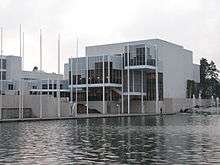Espoo
Espoo (Finnish: [ˈespoː]; Swedish: Esbo [ˈɛ̌sːbɔ], Finland Swedish: [ˈesːbo] (![]()
Espoo Espoo – Esbo | |
|---|---|
City and municipality | |
| Espoon kaupunki Esbo stad | |
 Clockwise from top: skyline of offices in Keilaniemi, Panorama Tower in Leppävaara, the Espoo Cultural Centre, Haukilahti docks, the Gallen-Kallela Museum, Aalto University Otaniemi campus auditorium, and Accountor Tower. | |
 Coat of arms | |
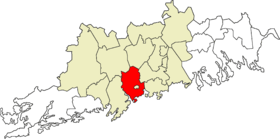 | |
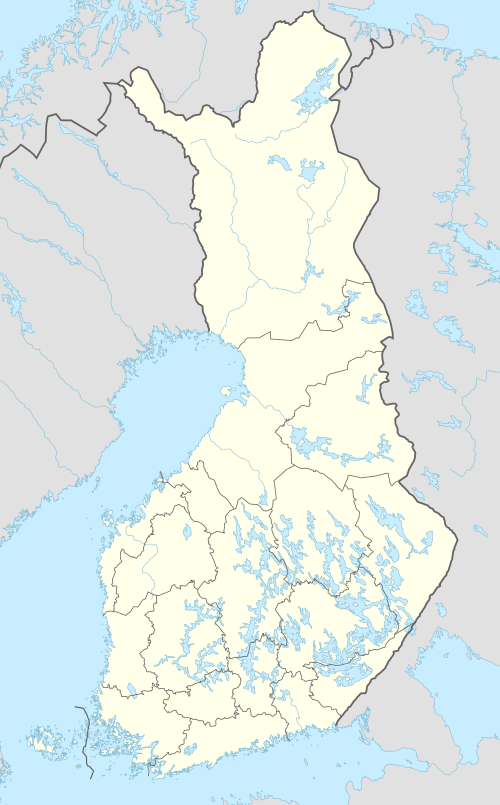 Espoo Location within Finland  Espoo Location within Europe | |
| Coordinates: 60°12′20″N 024°39′20″E | |
| Country | |
| Region | |
| Sub-region | Greater Helsinki |
| Charter | 1458 |
| City | 1972 |
| Government | |
| • City manager | Jukka Mäkelä |
| Area (2018-01-01)[1] | |
| • Total | 528.03 km2 (203.87 sq mi) |
| • Land | 312.26 km2 (120.56 sq mi) |
| • Water | 215.88 km2 (83.35 sq mi) |
| Area rank | 230th largest in Finland |
| Population (2019-01-31)[2] | |
| • Total | 284,444 |
| • Rank | 2nd largest in Finland |
| • Density | 910.92/km2 (2,359.3/sq mi) |
| Population by native language | |
| • Finnish | 83.6% (official) |
| • Swedish | 8.3% |
| • Others | 8% |
| Population by age | |
| • 0 to 14 | 19.7% |
| • 15 to 64 | 69.8% |
| • 65 or older | 10.5% |
| Time zone | UTC+02:00 (EET) |
| • Summer (DST) | UTC+03:00 (EEST) |
| Municipal tax rate[5] | 17.75% |
| Climate | Dfb |
| Website | www.espoo.fi |
Espoo encompasses 528 square kilometres (204 sq mi), of which 312 km2 (120 sq mi) is land.[1] The national park of Nuuksio is situated in northwestern Espoo.
Espoo does not have a traditional city center, having instead several local regional centers. Espoo is thus divided into seven major areas (Finnish: suuralueet, Swedish: storområden): Vanha-Espoo (with administrative center), Suur-Espoonlahti, Pohjois-Espoo, Suur-Kauklahti, Suur-Leppävaara, Suur-Matinkylä, and Suur-Tapiola.
Aalto University is based in Otaniemi, Espoo, along with a thriving science community that includes numerous startups and organizations such as VTT – the Technical Research Center of Finland. Several major companies are based in Espoo, including Nokia, HMD Global, Tieto, KONE, Neste, Fortum, Orion Corporation, Outokumpu, and Foreca, as well as video game developers Rovio and Remedy Entertainment.
The city of Espoo is officially bilingual. The majority of the population, 83.6%, speaks Finnish as their mother tongue, while a minority of 8.3% speaks Swedish. 8% of Espoo's population has a first language other than Finnish or Swedish.
Etymology
The name Espoo probably comes from the Swedish name for the River Espoo, Espå (or Espåå), which in turn comes from the old Swedish word äspe, meaning a border of aspen, and the Swedish word for "river", å, thus "a river bordered by aspen". The name was first mentioned in 1431. The banks of the River Espoo are even today heavily populated with aspen.
History

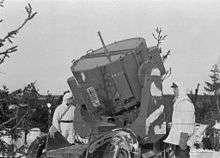
The first inhabitants in the area arrived about 9,000 years ago. Physical evidence (pollen grains) indicates agriculture from ca. 1000 AD, but there are no historical records. Up to the 13th century, the area was a borderland between the hunting grounds of Finnish Proper and Tavastian Finns, with a sparse population. Immigrants from Sweden established permanent agricultural settlements to the area from the late 13th century onwards after the so-called Second Crusade to Finland. Espoo was a subdivision of the Kirkkonummi congregation until 1486–1487. The oldest known document referring to Kirkkonummi is from 1330; Espoo as a subchapter has been dated to the 1380s, although the first document directly referring to Espoo is from as late as 1431. The construction of the Espoo Cathedral, the oldest preserved building in Espoo, marks the independence of Espoo. Administratively, Espoo was a part of Uusimaa. When the province was split to Eastern and Western provinces governed from the Porvoo and Raasepori castles, respectively, the eastern border of the Raasepori province was in Espoo. The 13th-century road connecting the most important cities in Finland at that time, the King's Road, passes through Espoo on its way from Stockholm via Turku and Porvoo to Viipuri.
In 1557, King Gustav Vasa decided to stabilize and develop the region by founding a royal mansion in Espoo. The government bought the villages of Espåby and Mankby (Finnish: Mankki) and transferred the population elsewhere, and built the royal mansion in Espåby. (Mankby was eventually abandoned and was never repopulated.) The royal mansion housed the king's local plenipotentiary (vogt), and collected royal tax in kind paid by labor on the mansion's farm. The administrative center Espoon keskus has grown around the church and the Espoo railway station, but the municipality has retained a network-like structure to the modern day.
In 1920, Espoo was only a rural municipality of about 9,000 inhabitants, of whom 70% were Swedish speaking. Agriculture was the primary source of income, with 75% of the population making their living from farming. Kauniainen was separated from Espoo in 1920, and it gained city rights the same year as Espoo, in 1972.
Espoo started to grow rapidly in the 1940s and '50s. It quickly developed from a rural municipality into a fully-fledged industrial city, gaining city rights in 1972. Due to its proximity to Helsinki, Espoo soon became popular amongst people working in the capital. In the fifty years from 1950 to 2000, the population of Espoo grew from 22,000 to 210,000. Since 1945, the majority of people in Espoo have been Finnish-speaking. In 2006, the Swedish-speaking inhabitants represented barely 9% of the total population. The population growth is still continuing, but at a slower rate.
Geography

Location
Espoo is located in southern Finland, along the shore of the Gulf of Finland, and in the region of Uusimaa and the Helsinki sub-region. Prior to the abolition of Finnish provinces in 2009, Espoo was a part of the Southern Finland Province.
The city borders Helsinki, the Finnish capital, which is to the east. Other neighbouring municipalities are Vantaa to the east and northeast, Nurmijärvi to the north, Vihti to the northwest, and Kirkkonummi to the west and southwest. Espoo is a part of the Finnish Capital Region, which is the inner core of the Greater Helsinki metropolitan area.
Subdivision
Espoo is divided into seven major areas (Finnish: suuralueet, Swedish: storområden): Vanha-Espoo (with administrative center), Suur-Espoonlahti, Pohjois-Espoo, Suur-Kauklahti, Suur-Leppävaara, Suur-Matinkylä, and Suur-Tapiola. These major areas are then divided into a total of 56 districts.
Features
Although Espoo is relatively highly populated, it has large amounts of natural wilderness, particularly in the city's western and northern portions. The city has a total of 71 lakes, the largest of which are Lake Bodom, Nuuksion Pitkäjärvi, Vanhankylän Pitkäjärvi, Loojärvi, Velskolan Pitkäjärvi, Saarijärvi, Matalajärvi, Siikajärvi, and Lippajärvi. The city has a large coastline on the Gulf of Finland.
Espoo has six Natura 2000 protected areas: Bånberget forests, Espoonlahti–Saunalahti bay area (partially in Kirkkonummi), Laajalahti bay, Matalajärvi lake, Nuuksio National Park (partially in Kirkkonummi and Vihti), as well as forests in Vestra (partially in Vantaa).
The official animal of Espoo is the Siberian flying squirrel, the official bird is the common blackbird, and the official plant is Anemone nemorosa.
Demographics
| Historical population of Espoo[6] | |||
|---|---|---|---|
| Year | Population | Year | Population |
| 1901 | 5,888 | 1985 | 156,778 |
| 1910 | 7,891 | 1990 | 172,629 |
| 1920 | 8,817 | 1995 | 191,247 |
| 1930 | 11,370 | 2000 | 213,271 |
| 1940 | 13,378 | 2005 | 231,704 |
| 1950 | 22,878 | 2010 | 247,970 |
| 1960 | 53,042 | 2013 | 260,753 |
| 1970 | 92,655 | 2020 (est.) | 281,970 |
| 1975 | 120,632 | 2030 (est.) | 306,965 |
| 1980 | 137,409 | 2040 (est.) | 323,875 |
| Population by grand district (in 2006) | |||
| Area | Population | Area | Population |
| Leppävaara | 58,048 | Vanha-Espoo | 33,613 |
| Espoonlahti | 48,649 | Pohjois-Espoo | 9,754 |
| Tapiola | 41,905 | Kauklahti | 6,191 |
| Matinkylä | 33,613 | ||
The population by citizenship in 2018 was 89.1% Finnish and 10.9% other nationalities. Religious affiliation was 53.6% Lutheran, 4.3% other, and 42.1% no religious affiliation.
Espoo contains many high income suburbs, and six out of the ten highest average income postal code areas in Finland are in Espoo.
Immigrants and language
| Population by mother tongue[7] | ||
| Language | Population (2018) | Percentage |
|---|---|---|
| Finnish | 215,533 | 75.99% |
| Swedish | 19,999 | 7.05% |
| Russian | 6,937 | 2.45% |
| Estonian | 5,974 | 2.11% |
| Arabic | 3,905 | 1.38% |
| English | 3,068 | 1.08% |
| Somali | 2,733 | 0.96% |
| Chinese | 2,672 | 0.94% |
| Albanian | 1,998 | 0.70% |
| Kurdish | 1,777 | 0.63% |
| Other | 19,036 | 6.71% |
In 2018, there were 48,346 residents with a foreign background, 17% of the population. The largest groups are from Estonia, Russia and Iraq.
| Largest groups of foreign residents[8] | |
| Nationality | Population (2018) |
|---|---|
| 6,966 | |
| 6,567 | |
| 3,181 | |
| 2,922 | |
| 2,660 | |
| 2,590 | |
| 2,468 | |
| 1,465 | |
| 1,345 | |
| 1,215 | |
Culture
Espoo hosts a Museum of Modern Art called EMMA (Espoo Museum of Modern Art), built in a renovated old print house, the WeeGee house, named after an old book print company Weilin & Göös. The same building hosts also Finland's only Museum of Horology (Finnish: Kellomuseo, Swedish: Urmuseum) and a Toy Museum. Glims Farmstead Museum is also located in the city. The Espoo cultural centre, home of the world-renowned Tapiola Sinfonietta, where numerous concerts and theater performances are held, is located in Tapiola (Swedish: Hagalund).
Espoo has several old manors of which two are open to the general public. The most important is Espoon kartano (Swedish: Esbo gård, Espoo Manor), first mentioned in maps in 1495, and belonging to the noble Ramsay family since 1756. The current main building dates back to 1914, but a mill dates from the 1750s and Finland oldest walved stone bridge from 1777 is on the King's Road (Finnish: Kuninkaantie, Swedish: Kungsvägen) which passes by the manor. The main building can be rented for weddings and similar occasions. Guided tours are available on request for groups. The other manor open to public is Pakankylän kartano, located on the northern shore of Lake Bodom. The manor hosts a restaurant and club rooms, partly with original furniture open to the public, but meant originally to Kaisankoti sanatory and old people's home located on ground of the manor.
The Metal band Children of Bodom comes from Espoo, Finland. They are named after the unsolved murder known as the Lake Bodom murders which took place at the shore of Lake Bodom, a lake in northern Espoo, in 1960. The bands Norther and Kiuas also come from Espoo.
The educational department took part in Lifelong Learning Programme 2007–2013 in Finland.
Sports

At the 1952 Summer Olympics, the city's Westend Tennis Hall hosted the fencing events.
Ice hockey
Espoo Blues was a successful hockey club; between 1998 and 2016 it iced a men's hockey team which played at the men's premier SM-liiga and a women's hockey team which played at the women's premier Naisten SM-sarja. The women's team, Espoo Blues Naiset, won 13 Finnish women's championships in the 18-year span (1998-2016), seven of them won consecutively. The men's and women's ice hockey teams were known as Kiekko-Espoo from 1984-1998 and 1990-1998 respectively.
In Spring 2016 Jääkiekko Espoo Oy, the organization which owned the clubs, declared bankruptcy.[9] A new club called Espoo United was established to replace Espoo Blues.[10] Espoo United's men's ice hockey team played at the second highest level Mestis. The Espoo United women's hockey team played at the highest level, Naisten Liiga, and won silver in the 2017 league championships. Espoo United was also active in basketball and the men's basketball team played at the second highest level; the women's basketball team played at the highest level, Naisten Korisliiga.
In August 2017, in what was described as an effort to stabilize the club's tenuous financial situation, Espoo United abandoned its women's teams in both ice hockey and basketball.[11] Espoo United's former women's basketball team quickly acquired transfer to Tapiolan Honka but the women's ice hockey team was left in an unsustainable situation.[12]
The Finnish Ice Hockey Association chose to intervene in September 2017 and created an organization that would allow the team to play under the name Espoo Blues until a better structure could be identified.[13] In April 2018, despite the dumping of its women's teams, Espoo United declared bankruptcy and its men's teams folded.[14]
In April 2019, the women's ice hockey team Espoo Blues merged with Kiekko Espoo Oy, a significant junior hockey club with the largest girls hockey program in the country, to become Kiekko-Espoo.[15] At the time of the merger, the team was the winningest team in Naisten Liiga history with 14 Naisten Liiga championships and a combined 24 Naisten Liiga championship medals over 29 seasons.
Football
FC Honka is the local professional football club. The men's team was promoted into the Finnish premier division (Veikkausliiga) for the first time in its history at the end of the 2005 season. They play their home matches at Tapiolan urheilupuisto.
Floorball
Espoo also has two floorball teams playing at highest level Salibandyliiga. The two teams are Esport Oilers and Westend Indians.
Athletes from Espoo
Espoo is the birthplace of 2007 Formula One World Champion Kimi Räikkönen, former Dallas Stars forward Jere Lehtinen (three time NHL Selke Trophy winner), former Formula One driver JJ Lehto, professional downhill mountain biker Matti Lehikoinen, professional ten-pin bowling star Osku Palermaa and 2009 European Figure Skating Champion Laura Lepistö.
Public transport
Espoo is well-served by public transport, through the Helsinki commuter rail network, the Helsinki Metro's Länsimetro extension opened in November 2017, and buses provided by Helsingin seudun liikenne. In 2024 the orbital Jokeri light rail line will connect Espoo to eastern Helsinki.
Politics
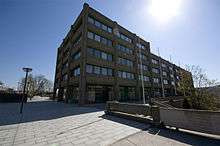
Espoo's city council has 75 members. Following the municipal election of 2017 the council seats are allocated in the following way: National Coalition Party 26 seats, Greens 17, Social Democrats 10, True Finns 7, Swedish People's Party 6, Centre Party 3, Left Alliance 3, Christian Democrats 2 and Liberal Party 1.[16]
Support for the center-right National Coalition Party is high in Espoo. Results of the 2011 Finnish parliamentary election in Espoo:
- National Coalition Party 40.4%
- True Finns 14.6%
- Social Democratic Party 14.4%
- Green League 11.6%
- Swedish People's Party 6.7%
- Centre Party 4.3%
- Left Alliance 3.6%
- Christian Democrats 2.7%
Espoo is the home for the former True Finns chairman Timo Soini.
International relations
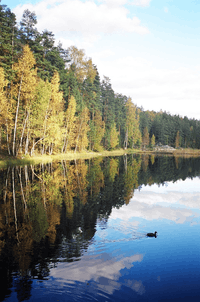
Twin towns – sister cities
Espoo is twinned with:[17]
|
|
Notable people
- Susan Aho (born 1974), singer and member of the band Värttinä
- Eero Ettala (born 1984), snowboarder
- Kirsi Heikkinen (born 1978), football referee
- Krista Kosonen (born 1983), actor
- Alexi Laiho (born 1979), guitarist and vocalist, co-founder of the metal band Children of Bodom
- Jere Lehtinen (born 1973), ice hockey player
- JJ Lehto (born 1966), racing driver
- Laura Lepistö (born 1988), figure skater
- Kimi Räikkönen (born 1979), racing driver and Formula One World Champion
- Joonas Suotamo (born 1986), actor in the Star Wars series and a former professional basketball player
- Gösta Sundqvist (1957–2003), bandleader of Leevi and the Leavings
See also
References
Notes
- "Area of Finnish Municipalities 1.1.2018" (PDF). National Land Survey of Finland. Retrieved 30 January 2018.
- "Suomen virallinen tilasto (SVT): Väestön ennakkotilasto [verkkojulkaisu]. Tammikuu 2019" (in Finnish). Statistics Finland. Retrieved 15 March 2019.
- "Population according to language and the number of foreigners and land area km2 by area as of 31 December 2008". Statistics Finland's PX-Web databases. Statistics Finland. Retrieved 29 March 2009.
- "Population according to age and gender by area as of 31 December 2008". Statistics Finland's PX-Web databases. Statistics Finland. Retrieved 28 April 2009.
- "List of municipal and parish tax rates in 2011". Tax Administration of Finland. 29 November 2010. Retrieved 13 March 2011.
- Tilastokeskus. "Population statistics", Tilastokeskus, Retrieved on 9 June 2014.
- http://pxnet2.stat.fi/PXWeb/pxweb/fi/StatFin/StatFin__vrm__vaerak/statfin_vaerak_pxt_11rm.px/
- http://pxnet2.stat.fi/PXWeb/pxweb/fi/StatFin/StatFin__vrm__vaerak/statfin_vaerak_pxt_11rv.px/
- Hiitelä, Juha (12 April 2016). "Konkurssipesä myöntää: Bluesin tilanteeseen ei ratkaisua" [The bankrupt organization concedes: Blues situation has no solution]. Ilta-Sanomat (in Finnish). Retrieved 15 July 2019.
- Lempinen, Marko (28 April 2016). "Nyt se on varmaa: Jussi Salonoja perusti uuden seuran – "Lähetän hakupaperit tänään"" [Now it is certain: Jussi Salonoja founded a new club - "I'm submitting league admittance papers today"]. Ilta-Sanomat (in Finnish). Retrieved 15 July 2019.
- Oivio, Janne; Lempinen, Marko (15 August 2017). "Jussi Salonojalta raju ratkaisu: Espoo United hylkää naisjoukkueet" [Jussi Salonoja's drastic solution: Espoo United to abandon women's teams]. Ilta-Sanomat (in Finnish). Retrieved 15 July 2019.
- Foster, Meredith (17 August 2017). "Espoo United women's team folds one month before puck drop". The Ice Garden. Retrieved 15 July 2019.
- Foster, Meredith (4 September 2017). "Blue Monday: Blues Espoo join Naisten Liiga". The Ice Garden. Retrieved 15 July 2019.
- "Espoo Unitedin konkurssista tuli virallista" [Espoo United's bankruptcy becomes official]. Ilta-Sanomat (in Finnish). 4 May 2018. Retrieved 15 July 2019.
- Foster, Meredith (30 April 2019). "Kiekko-Espoo absorb Espoo Blues, rejoin top tier". The Ice Garden. Retrieved 15 July 2019.
- "Espoo: Tulos puolueittain ja yhteislistoittain". Ministry of Justice. 13 April 2017. Retrieved 16 April 2017.
- "Networks". City of Espoo. Retrieved 6 October 2018.
- "Interactive City Directory". Sister Cities International. Archived from the original on 12 March 2014. Retrieved 12 March 2014.
Sources
- Espoon kaupungin taskutilasto 2007, issued by the City of Espoo, 2007
External links
| Wikimedia Commons has media related to Espoo. |
| Wikivoyage has a travel guide for Espoo. |
- 1952 Summer Olympics official report. p. 50.
- City of Espoo – Official website (in Finnish)
- City of Espoo (Esbo) – Official website (in Swedish)
- City of Espoo – Official website (in English)
- Visit Espoo Espoo for travellers (in Finnish, Swedish, and English)
- Helsinki University of Technology – located in Espoo (in Finnish, Swedish, and English)
- Helsinki.fi – Helsinki region in a nutshell (in Finnish, Swedish, and English)
